In this post I show you how easy it is to cook a slow roast turkey leg. The dark turkey leg meat is more flavourful, compared to the light breast meat. This results in great tasting turkey juices (turkey drippings) which make the best turkey gravy, and I do love a proper homemade gravy.

A whole leg, portioned here into a turkey drumstick and thigh, is a perfect serving to 2. It's the ideal joint for those looking for a smaller cut of meat, and who don't want to be eating turkey for days on end.
Turkey legs also cost significantly less than a whole turkey, or a turkey crown, which can be really expensive. Turkey legs are definitely the best option for those on a budget. However, you won't be compromising on flavour the dark leg meat is more flavourful, than the white breast meat.
With my easy roasted turkey leg recipe I prefer a slow roast rather than a fast roast. This results in moist and tender pieces of turkey meat that just fall off the bone.
My slow roast turkey leg makes a great option for a smaller Thanksgiving or Christmas get together. However, don't limit yourself to only eating turkey for Thanksgiving or Christmas. It makes a great budget friendly roast any time of the year.
Why you'll love this recipe
- The dark roast turkey leg meat has a lot more flavour than the lean white breast meat.
- Cook low and slow for deliciously tender pieces of fall apart turkey leg meat.
- Turkey leg is a great budget cut as turkey leg if for less expensive than a whole turkey, or turkey crown which can be pricy.
- This is an easy cook, just assemble the roasting dish then leave the oven to do all the work, while you get on with preparing any sides.
- Use gluten free stock and this dish can be served to coeliacs or anyone following a gluten free diet.
Recipe ingredients
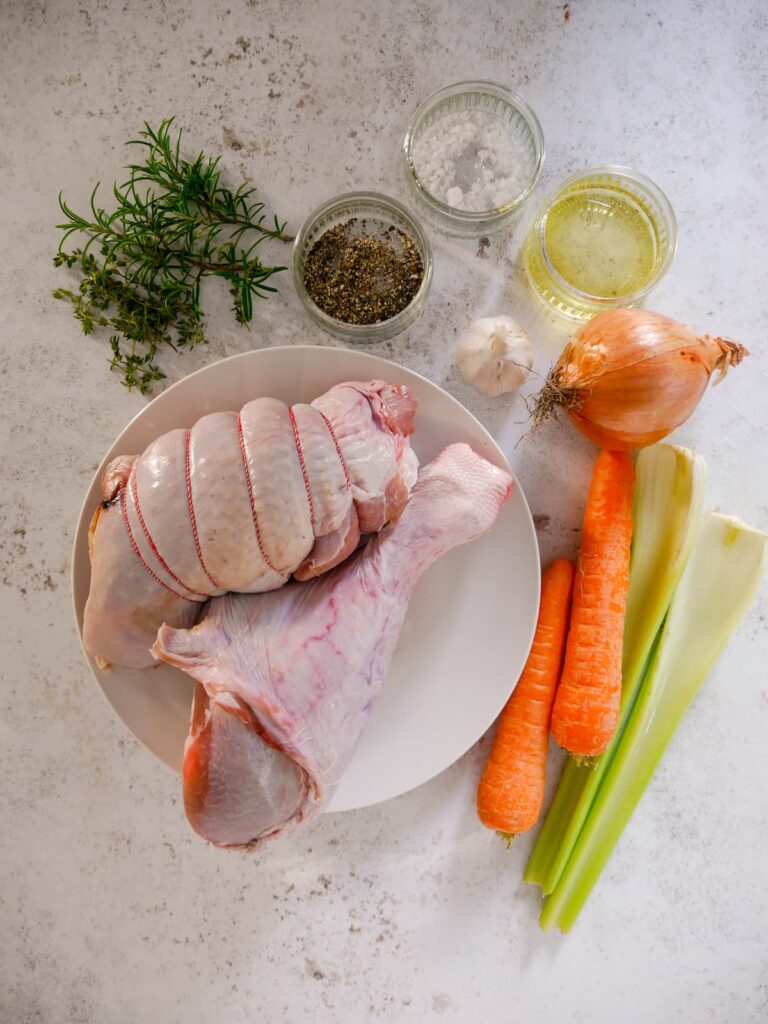
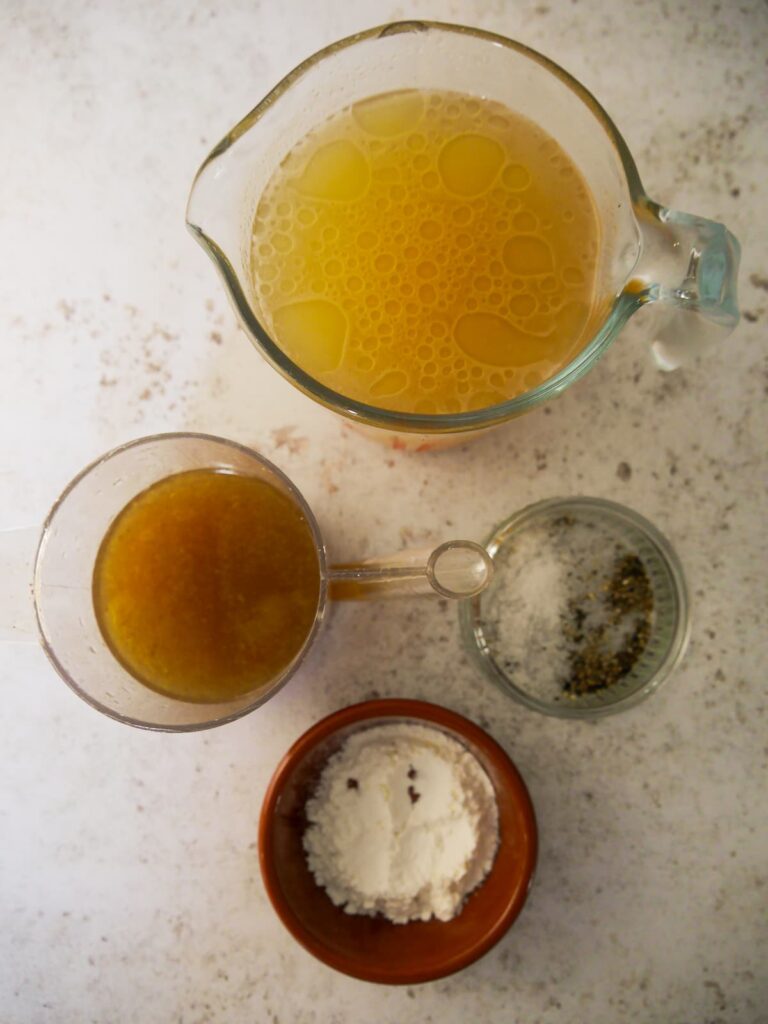
- Turkey - I used a 1.6 kg (3.5 lb) turkey leg, which had been portions into 2 joints, a turkey drumstick and a thigh portion. This will easily feed 2 diners.
- Vegetables - I added onion, carrots and celery to the base of the roasting dish, you could also add a leek if you have one. This adds great flavour to the turkey juices while cooking, resulting in great flavoured turkey juices/turkey dripping for the gravy.
- Chicken stock - I added a little chicken stock to the base of the roasting dish, this helps keep the turkey moist while it cooks. You could also use water, but chicken stock will give you a better flavoured gravy.
- Fresh herbs - I use fresh garlic, rosemary and thyme in the trivet. Then added extra rosemary and thyme to olive oil for rubbing over the turkey leg.
- Oil - I used a little regular olive oil for rubbing over the turkey. You could also use sunflower, rapeseed or avocado oil.
- Seasoning - I seasoned the turkey legs with some sea salt and black pepper.
Turkey gravy ingredients
- Turkey juices (or turkey drippings) - I never throw away any cooking juices from the bottom of the roasting dish, they add so much flavour to the gravy.
- Stock (broth) - for the best results use turkey or chicken stock to make the gravy. Use a gluten free stock in required. I like to use my Homemade Chicken Stock as it has great flavour, and no other additives.
- Cornflour - I mix cornflour with a little water to form a thin paste which I add into the warm stock. This helps to thicken the gravy. Cornflour is also gluten free making this gravy suitable for coeliacs or anyone following a gluten free diet.
- Seasoning - I season the gravy to taste with sea salt and black pepper.
How to roast turkey leg in oven
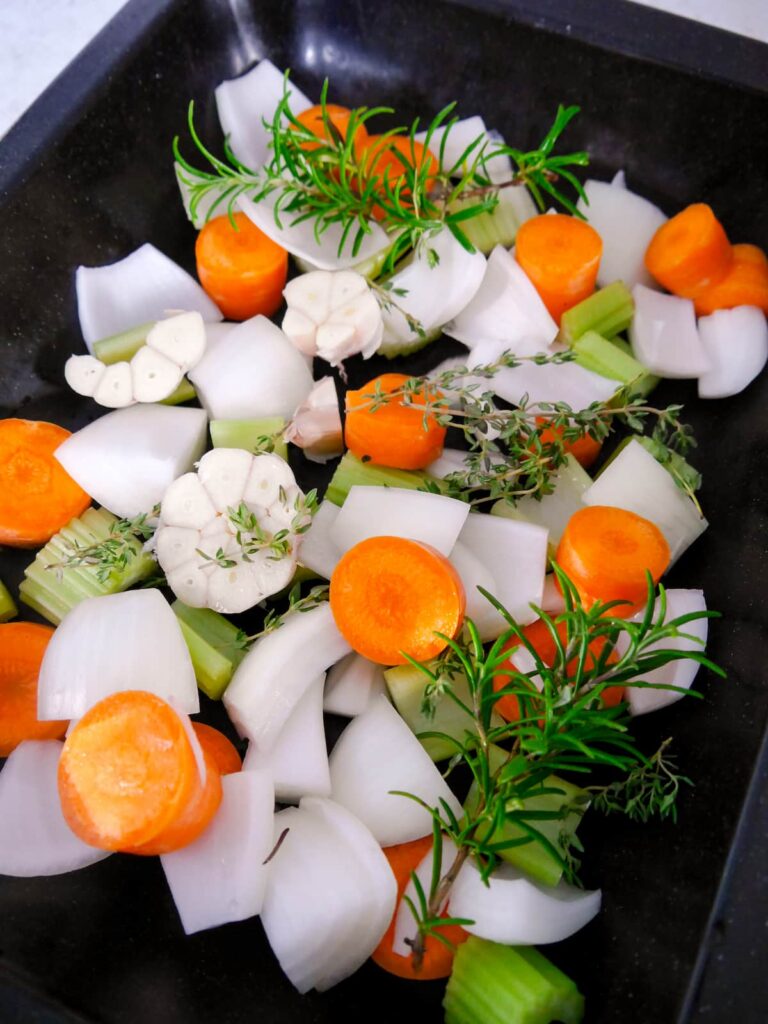

- Preheat the oven to 140CFan/160C/325F.
- Prepare the vegetables and garlic bulb and place in the bottom of the roasting dish, along with 2 sprigs of thyme, 2 of rosemary and the chicken stock or water.
- Roughly chop the remaining rosemary and thyme and add to the olive oil with the salt and pepper.
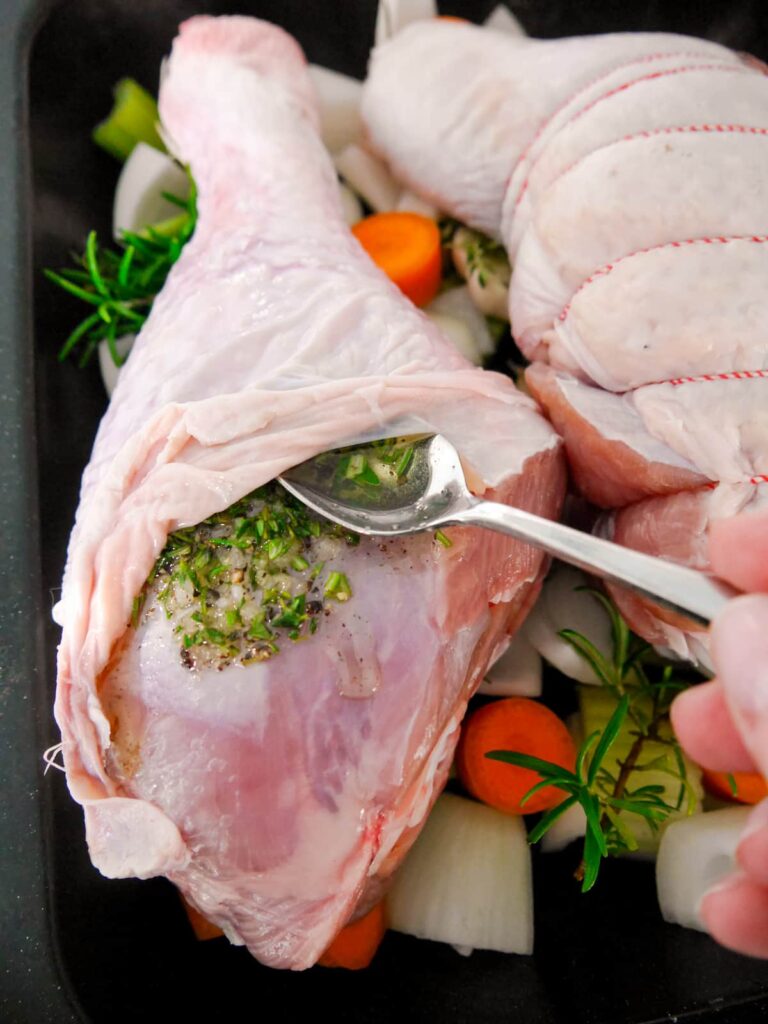
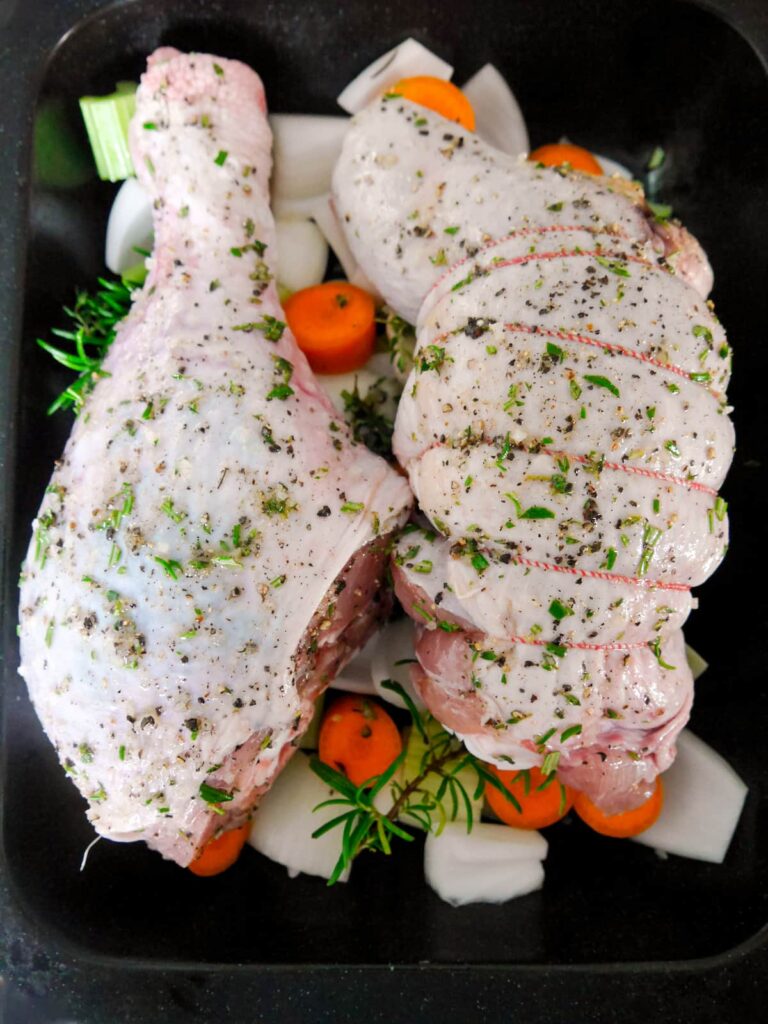
- Gently push back the skin on the turkey and rub some of the herby olive oil directly onto the skin. Pull the skin back over the meat and pour the remaining herb oil over the skin of both joints and rub all over.
- Place the turkey leg and thigh on top of the vegetables, cover with kitchen foil, and place the roasting dish into the hot oven for 2 hours. Turn the turkey legs midway through the cook.
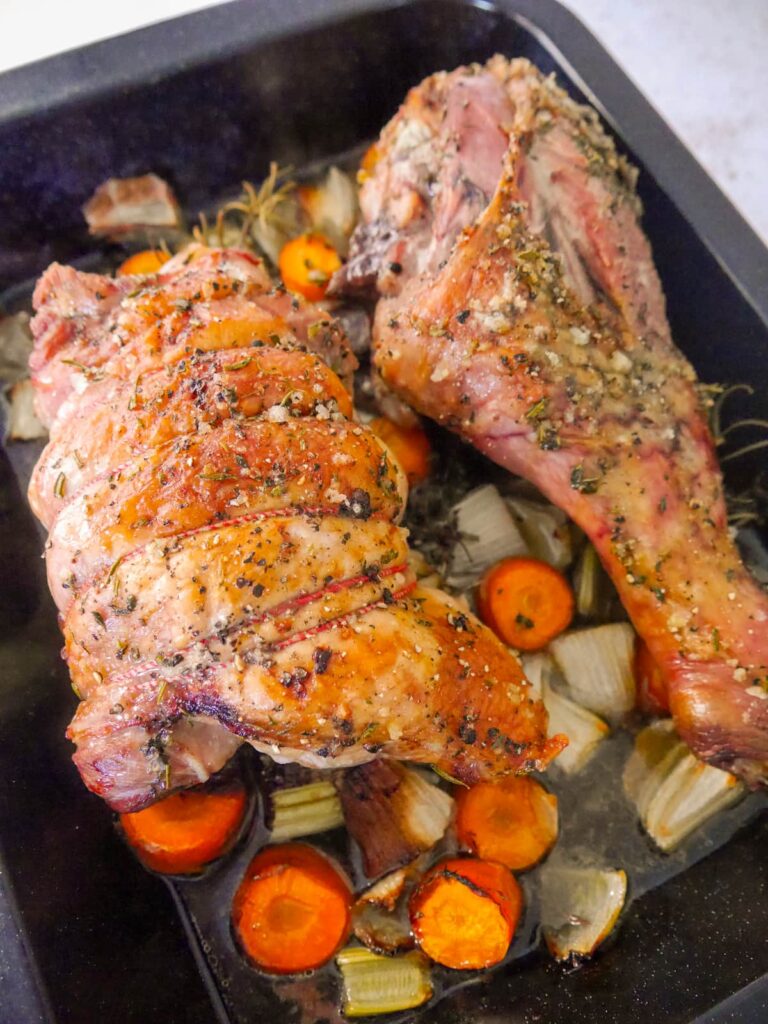
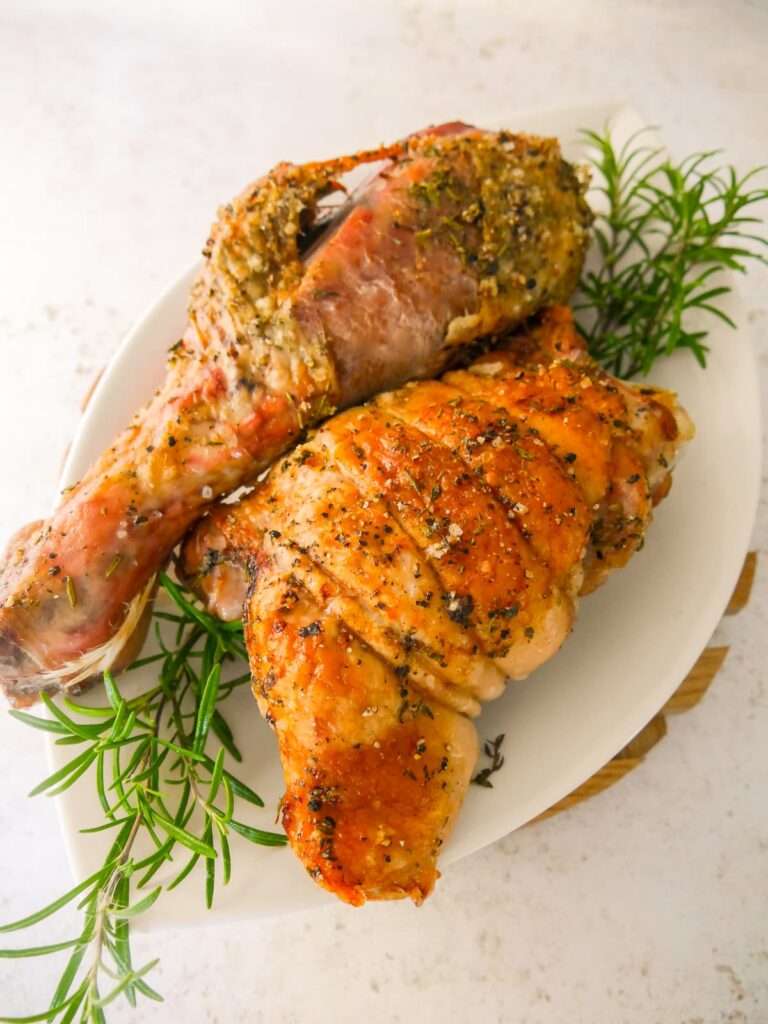
- After 2 hours turn up the heat on the oven to 200CFan/220C/430F.
- Remove the kitchen foil and continue roasting the turkey for a further 20-25 minutes to crisp up the skin. By this point the turkey will be cooked. It should reach an internal temperature of 74C/165F at the thickest part.
- Remove the tray from the oven, cover the turkey loosely with foil and set aside to rest for 10 minutes.
- Once the turkey has rested for 10 minutes, remove onto a chopping board and keep covered with the foil. Rest the turkey for a further 10 minutes, while you make the gravy.
How to make turkey gravy
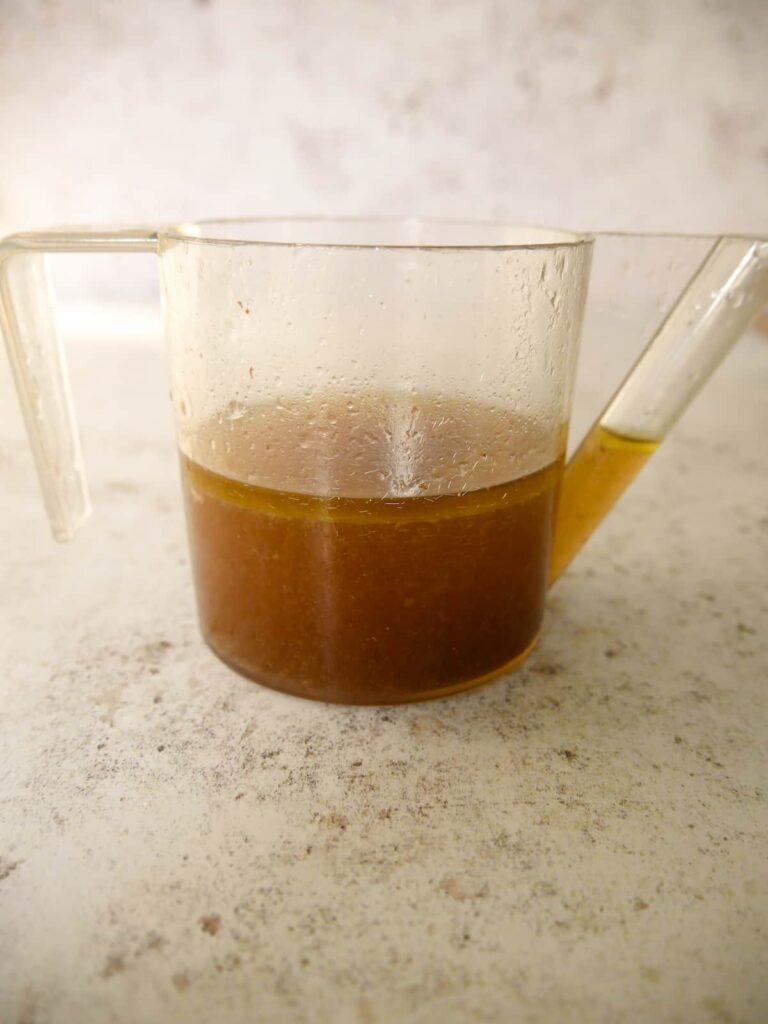
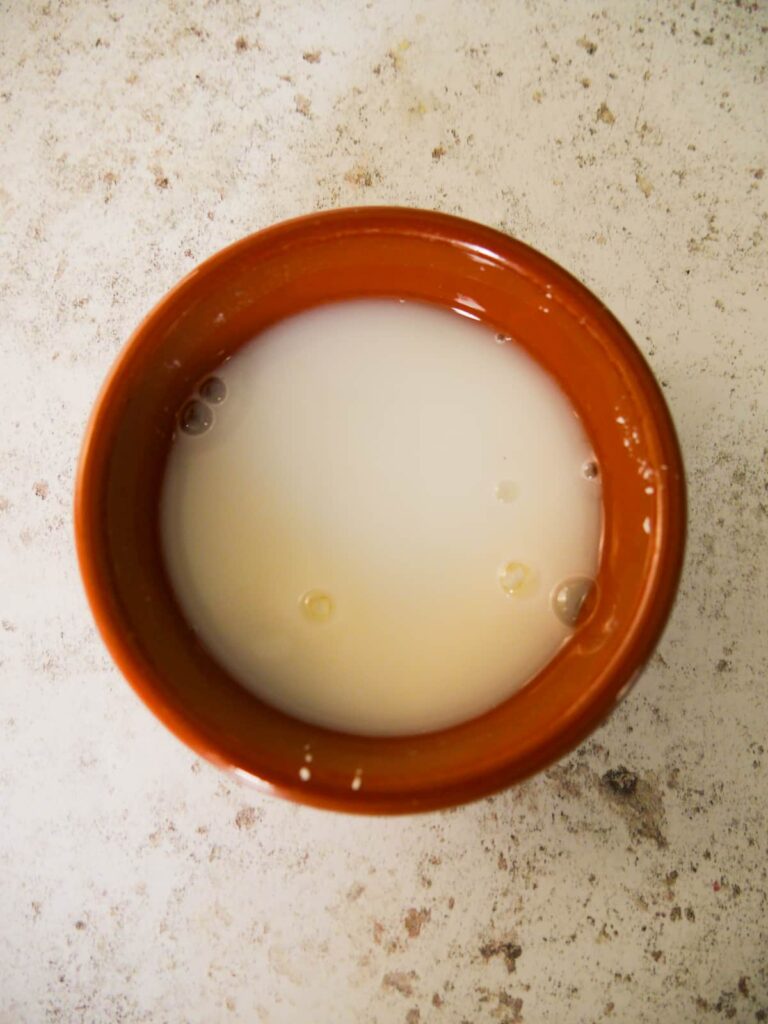
- Strain off the turkey cooking juices from the roasting pan into a jug or bowl. Leave to settle for a few minutes and then skim off any fat that has floated to the surface.
- Add the cornflour and water to a small bowl and mix to form a paste.
TOP TIP: For ease, when straining turkey drippings, I like to use a fat separating jug - see image above left. The fats rise to the top making the turkey juices below really easy to pour off.
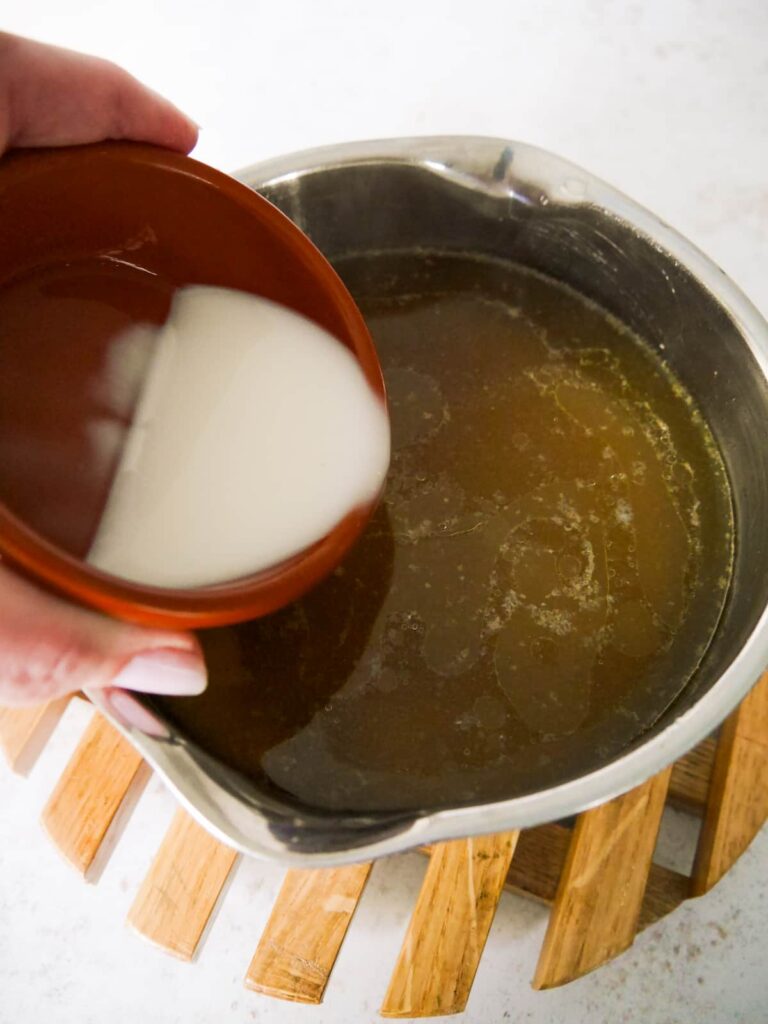
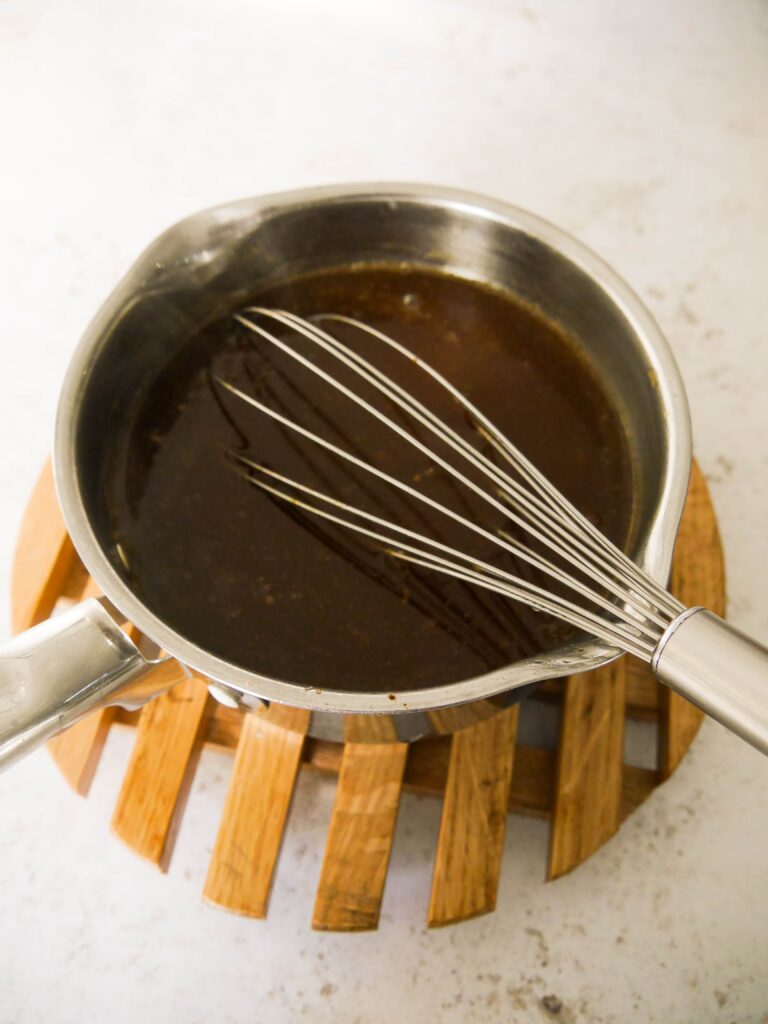
- Place the turkey juices into a saucepan, along with the turkey or chicken stock. Bring to a boil, then turn the heat down to medium.
- Pour the cornflour mixture into the saucepan, whisk to combine and remove any lumps, and gently heat up the gravy again until it has thickened. Taste the gravy check for seasoning, and adjust to taste.
- Pour into a warm gravy jug and serve.

What to serve with roast turkey leg
I like to serve roast turkey leg with a potato side like my Best Roast Potatoes, or Easy Hasselback Potatoes with Thyme Butter.
I always include 2-3 vegetable side dishes like my Roasted Brussels Sprouts with Bacon & Chestnuts, Braised Red Cabbage, Easy Honey Roasted Vegetables, or Gluten Free Cauliflower Cheese.
For something extra special, I like to add Scottish Oatmeal Stuffing to pretty much any roast, and if I'm going all out for flavour I serve my Easy Sausagemeat Stuffing Balls.
What to do with leftover turkey?
When I have leftover turkey I like to use it in other dishes, rather than a simple turkey sandwich. For something a little more flavorful try my Turkey Leftover Pie, which also makes great use of any leftover roasted vegetables or turkey gravy you might have too.
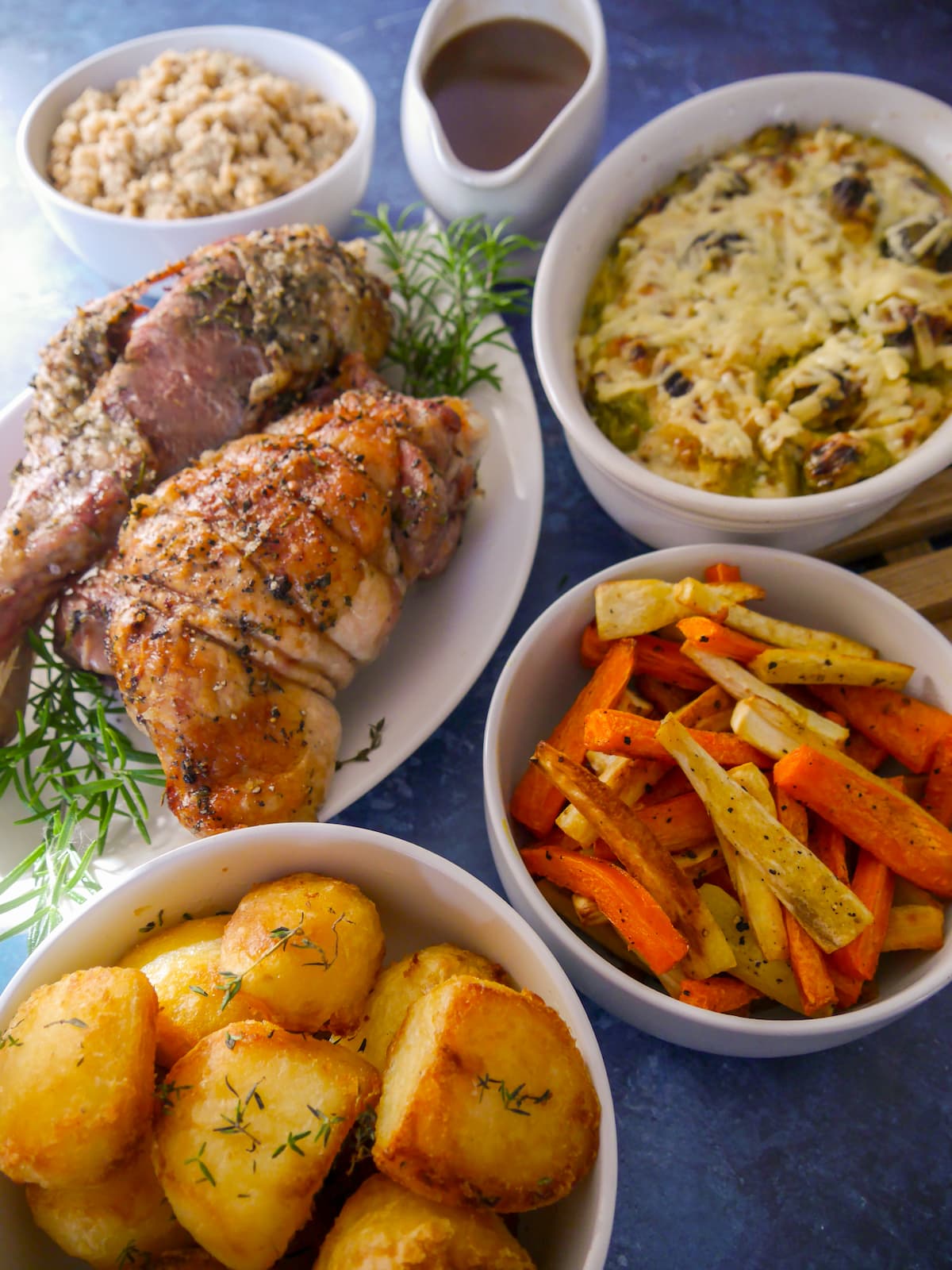
Useful hints and tips
- It's really important to rest the turkey leg once cooked, to allow the juices to be absorbed back into the leg. This will give you moist and tender turkey leg meat.
- When portioning and cutting up the cooked turkey leg, take care to remove any of the thin bones and tendons before serving.
- Separating fat from turkey cooking juices: When straining off the turkey cooking juices (turkey drippings), I like to use a fat separator jug which makes things a lot easier. However, you can also use a regular jug or bowl and just skim off the fat with a spoon.
- When to season gravy? When making the gravy, only season it at the end of the cook before serving. How much salt and pepper you add will depend on the stock you are using. I used my homemade chicken stock which I do not add any salt to. However, some store bought stocks can contain quite a bit of salt so I recommend tasting the gravy first and then seasoning to taste.
- Allergy advice: gluten free, dairy free, egg free, soya free and nut free. For comprehensive and detailed allergy advice go to Allergy UK.
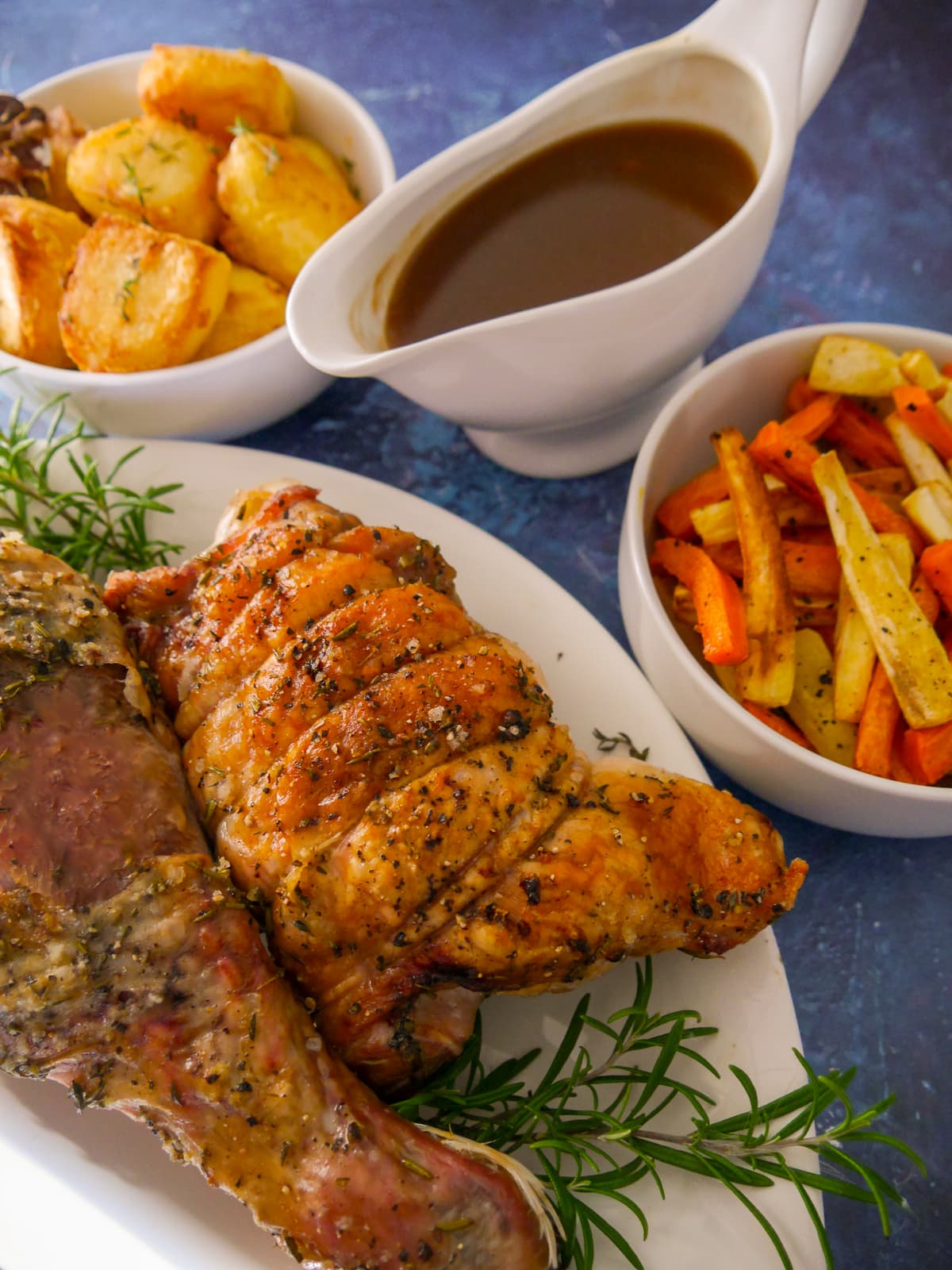
FAQs
When cooked, turkey should reach an internal temperature of 74C/165F at the thickest part. For ease, I like to use a meat probe thermometer to do this.
If you don't have a thermometer, then simply insert a sharp knife into the thickest part of the turkey, remove the knife and gently press the incision to release the internal cooking juices. If the juices run clear the turkey is cooked, if they are pink the turkey needs longer to cook and you should return to the oven. Work up in 5 minute intervals until the meat is cooked through.
If you want to avoid tough turkey legs, the best method is to cook them low and slow in a little chicken stock or water. By braising the turkey legs, you are reducing the roasting temperature and cooking them longer, the turkey meat will become fall apart tender.
Once cooked and cooled, place in a airtight container and store in the fridge for up to 3 days.
Yes, only reheat the cooked turkey once. Heat it up to piping hot, you can heat it up in the gravy to stop it drying out.
Once cooked and cooled, place the turkey into an airtight container or Ziploc bag, and store in the freezer for up to 3 months. When ready to enjoy, defrost in the fridge.
Pin the recipe
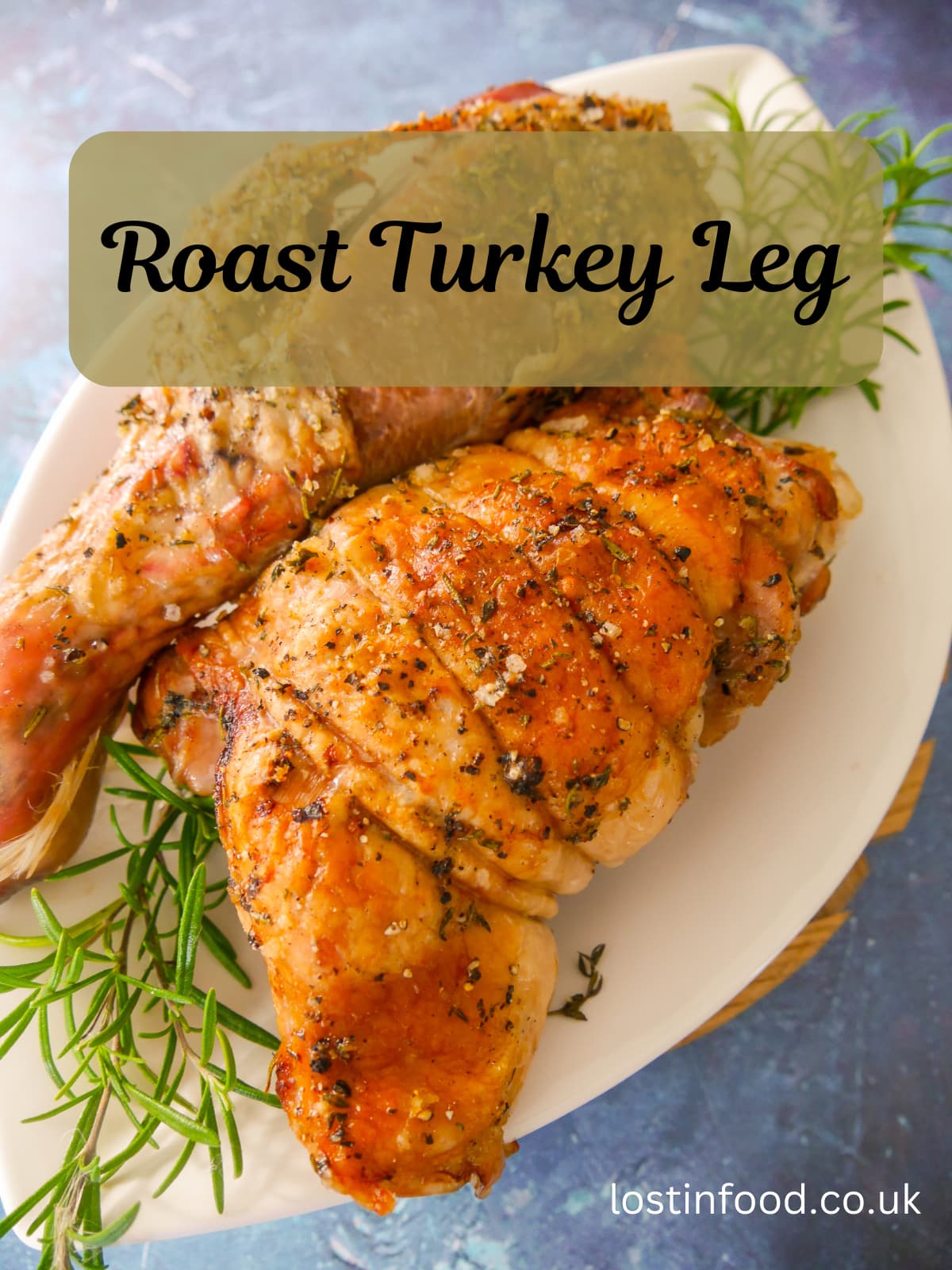
Additional recipe suggestions
If you like this recipe then try some of my other easy roast recipes:
- Roast Turkey Crown
- Roast Pork Belly with Crispy Crackling
- Pork Fillet wrapped in Bacon & Thyme
- Roast Leg of Pork with Bacon & Cranberries
- Pan Roasted Guinea Fowl with Chicken Jus
- Pan Roasted Chicken with Asparagus & Peas
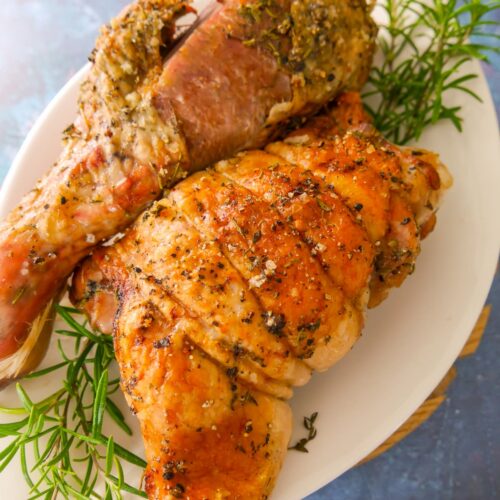
Slow Roast Turkey Leg
Equipment
- chopping board
- Sharp kitchen knife
- Medium sized roasting dish large enough to hold the turkey drumstick and thigh
- Kitchen foil
Ingredients
Roast turkey
- 1.6 kg turkey leg (includes drumstick and thigh portions)
- 1 onion (roughly chopped)
- 2 carrots (roughly chopped)
- 2 stalks celery (roughly chopped)
- 1 bulb garlic (cut in half and lightly crushed)
- 4 sprigs rosemary (divided)
- 4 sprigs thyme (divided)
- 200 ml chicken stock or water
- 2 tablespoon olive oil
- 1 teaspoon sea salt (divided)
- 1 teaspoon black pepper (divided)
Turkey gravy
- strained off roast turkey juices
- 3 tablespoon cornflour
- 2 tablespoon water
- 450 ml turkey or chicken stock
- sea salt & black pepper (to taste)
Instructions
How to roast turkey leg
- Preheat the oven to 140CFan/160C/325F.
- Prepare the vegetables and garlic bulb and place in the bottom of the roasting dish, along with 2 sprigs of thyme, 2 of rosemary and the chicken stock or water.
- Roughly chop the remaining rosemary and thyme and add to the olive oil with the salt and pepper.
- Gently push back the skin on the turkey and rub some of the herby olive oil directly onto the skin. Pull the skin back over the meat and pour the remaining herb oil over the skin of both joints and rub all over.
- Place the turkey leg and thigh on top of the vegetables, cover with a layer of kitchen foil, and place the roasting dish into the hot oven for 2 hours. Turn the turkey legs midway through the cook.
- After 2 hours turn up the heat on the oven to 200CFan/220C/430F.
- Remove the kitchen foil and continue roasting the turkey for a further 20-25 minutes to crisp up the skin. By this point the turkey will be cooked. It should reach an internal temperature of 74C/165F at the thickest part.
- Remove the tray from the oven, cover the turkey loosely with foil and set aside to rest for 10 minutes.
- Once the turkey has rested for 10 minutes, remove onto a chopping board and keep covered with the foil. Rest the turkey for a further 10 minutes, while you make the gravy.
How to make turkey gravy
- Strain off the turkey cooking juices from the roasting pan into a jug or bowl. Leave to settle for a few minutes and then skim off any fat that has floated to the surface.
- Add the cornflour and water to a small bowl and mix to form a paste.
- Place the turkey juices into a saucepan, along with the turkey or chicken stock. Bring to a boil, then turn the heat down to medium.
- Pour the cornflour mixture into the saucepan, whisk to combine and remove any lumps, and gently heat up the gravy again until it has thickened. Taste the gravy check for seasoning, and adjust to taste.
- Pour into a warm gravy jug and serve.
Notes
- Cooking the turkey low and slow gives you the best flavor and lovely soft pieces of turkey which are fall off the bone tender.
- When cooked turkey should reach an internal temperature of 74C/165F at the thickest part. For ease, I like to use a meat probe thermometer to do this.
- If you don't have a thermometer, then simply insert a sharp knife into the thickest part of the turkey, remove the knife and gently press the incision to release the internal cooking juices. If the juices run clear the turkey is cooked, if they are pink the turkey needs longer to cook and you should return to the oven. Work up in 5 minute intervals until the meat is cooked through.
- When straining off the turkey cooking juices, I like to use a fat separator jug which makes things a lot easier. However, you can also use a regular jug or bowl and just skim off the fat with a spoon.
- When making the gravy, only season it at the end of the cook before serving. How much salt and pepper you add will depend on the stock you are using. I used my homemade chicken stock which I do not add any salt to. However, some store bought stocks can contain quite a bit of salt so I recommend tasting the gravy first and then seasoning to taste.
• Please note that the nutrition information provided above is approximate and meant as a guideline only •

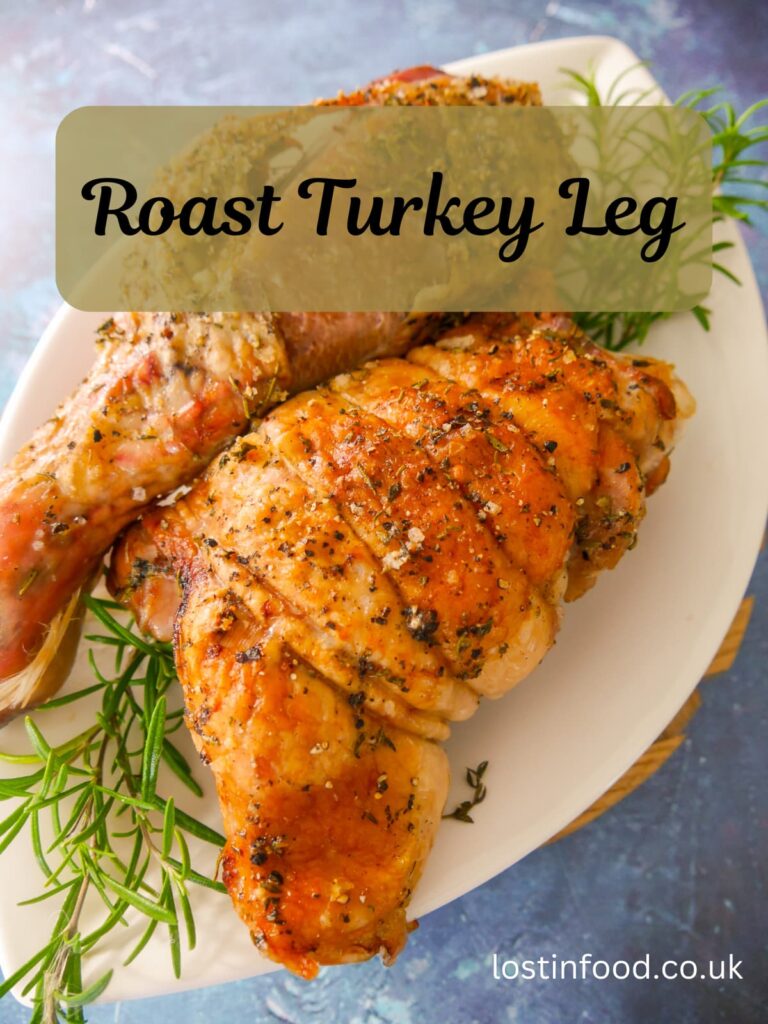
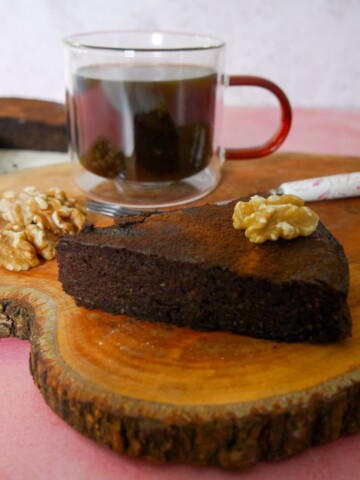
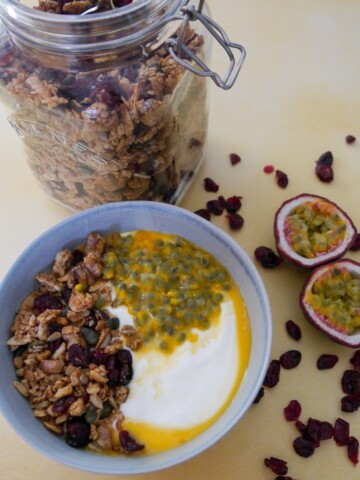

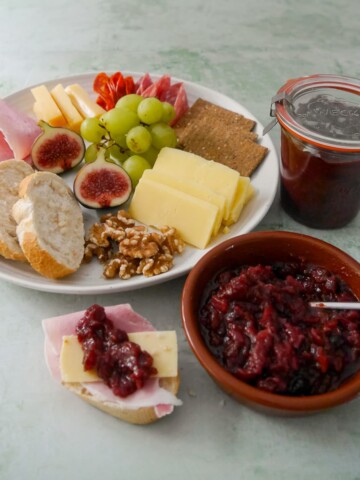
Angie says
We love Turkey especially Leg and Thigh meat, this recipe never fails we have one today so looking forward to the meal with all the trimmings.
Lesley says
I'm really happy to hear that Angie, I prefer the leg meat, so much more flavour and slow cooking makes it really easy.
Sisley White - Sew White says
This recipe really took the fear of cooking turkey away. Thank you
Lesley says
Thank you Sisley, I'm glad you enjoyed it.
Cat says
I usually prefer leg meat over breast so this is definitely the recipe for me. So full of flavour and simple to make.
Lesley says
Thank you Cat, my family are the same, the leg meat it always what they go for.
Janice says
I made this at the weekend and it was so delicious. Thanks for the great recipe.
Lesley says
Thank you Janice, I'm glad you enjoyed it.
Chloe says
I'm so pro turkey legs, they're economical and the tastiest part, especially the thigh part. This method worked great and the gravy was a flavour bomb!
Lesley says
Thank you Chloe, I totally agree, a great budget option with far more flavour.